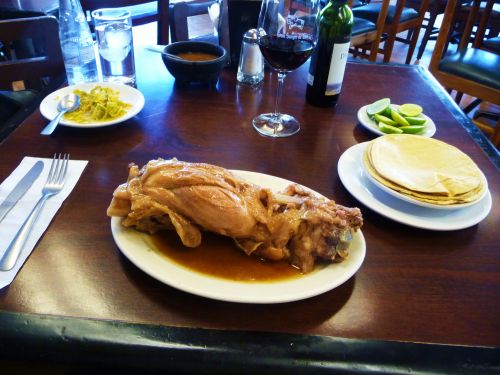Bye bye New Orleans

It's been swell. But I pretty much took care of what I had to take care of here. So I am giving up my New Orleans apartment. With my mitigation work, I will have to travel between the U.S. and Mexico constantly. But this last year, in which I spent more time in the U.S. than I had in ages, I realized just how much Mexico City has become home to me. And how important it is to have a home.

New Orleans is a unique place. That is a Japanese pot-bellied pig playing with the puppy.

Sometimes it's a little jarring. The words on this house exhort readers to "shoot a thief," holdover instructions from the looting after Hurricane Katrina in 2005. Just a few weeks ago, the owners of the property repainted the facade, with a sign for Dixie beer.

It's not always functional, in terms of infrastructure or distribution of goods and services. Sometimes I felt that I had to live for many years in Mexico to get to New Orleans -- the third world. It will always have an important place in my heart and remain on my map.
Don't tell Allah you ate here
When I got to Mexico City all those years ago I was never very enthusiastic about eating a dish called chamorro, a pork shank so huge that when it is finished it looks like a lost dinosaur bone. But then an advertising executive named Jorge Loaeza invited me to join him at a cantina called Bar El Sella, on Calle Dr. Balmis #210, a stone's throw from Avenida Cuauhtémoc and just a few steps into the Colonia Doctores. El Sella's version of chamorro (pictured above) is braised and steamed and so delicious that I am convinced it would convert any Jew or Muslim who took the trouble to eat it.
Other house specialties are variations of the tortilla española and parsely fried in bacon fat. It is around the corner from the Hospital General, so many of its patrons are doctors in their lab coats on their lunch hour. Last time I was at El Sella, I spied a table full of medical men, sharing a chamorro, a tortilla and a steak. Given their menu choices, I asked them if they were cardiologists. I'm afraid they didn't think I was very funny.

A hotel with a past

The Hotel Roosevelt, which abuts the Colonia Condesa on Avenida Insurgentes and Avenida Veracruz, opened its doors in 1938. Anecdotes about its past proliferate. Until the mid-1940s, there was a bullfight stadium located in walking distance. An arrangement was made in which the toreros were allowed to change into their bullfighting gear at the Roosevelt, and then march through the streets, parade-style, to the arena. Cubans swear that this is where Fidel and Che stayed while planning the revolution in the late 1950s. Actor Ignacio López Tarso recalled a friendly manager who allowed him to sleep on the roof in the 1950s, before he became a star of Mexican cinema.
By the early 1990s, the Roosevelt had acquired a seedy reputation. Some women who worked at a couple of notorious night spots in spitting distance, the Bar Jemma and Cherry's Bar, would take their clients to the hotel to exercise the world's oldest profession. Soon after, the clubs closed down and a new management took over. Rooms were renovated and the facade was changed (as was the hotel's reptuation). Over the summer, the facade was repainted -- how long will it remain that white? Today it is one of the very few modestly priced hotels in the area, a decidedly expensive neighborhood by Mexico City standards.
Stompin' at the Savoy

Prior to World War II, Mexico's greatest cultural influence came from France rather than the United States. In the early 20th century, many office buildings in the historic center of Mexico City were designed with commercial arcades that cut through the ground floor, an architectural innovation from the 1800s in Paris. Such arcades inspired an unfinished book of some thousand pages by Walter Benjamin, and were part of what inspired him to call Paris "the capital of the 19th century. "
This is one of the few such arcades that still survives downtown, on calle 16 de septiembre #6, almost at the corner of the Eje Central. Its offerings include a men's haberdashery, a cafe and, in the right-hand foreground, a branch of Mazapanes Toledo, which has prepared and sold marzipan candies since 1939.
In the back of the arcade is a movie theatre known as the Cine Savoy, which has been there since 1943. These days it caters to the sort of clientele, exclusively male, that tends to go to the cinema clad in raincoats, regardless of the weather. One of my favorite Mexican writers, J.M. Servín, has a chronicle about his visit to the Savoy in his delightful new book, D.F. Confidencial.

